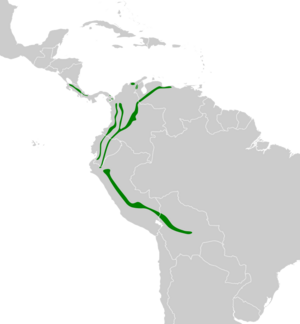Spotted barbtail facts for kids
Quick facts for kids Spotted barbtail |
|
|---|---|
 |
|
| Conservation status | |
| Scientific classification | |
| Genus: |
Premnoplex
|
| Species: |
brunnescens
|
 |
|
The spotted barbtail (Premnoplex brunnescens) is a small bird that lives in moist mountain forests. It belongs to the Furnariidae family, which are often called 'ovenbirds' because some of them build oven-shaped nests. You can find this bird in warm, wet forests high up in the mountains.
Contents
About the Spotted Barbtail
The spotted barbtail was first officially described in 1856. It was found in Bogota, Colombia. For a while, people thought it was the same as another bird, the white-throated barbtail. But now, scientists know they are different, though they are still very closely related.
Scientists have found five different types, or subspecies, of the spotted barbtail. These subspecies look a bit different and live in various places:
- P. b. brunneicauda: Lives in Costa Rica and western Panama.
- P. b. brunnescens: Found in eastern Panama, parts of western Colombia, and the mountains of western Venezuela, all the way down to Ecuador and Peru.
- P. b. coloratus: Only lives in the Santa Marta Mountains in northern Colombia.
- P. b. rostratus: Found in the coastal mountains of northern Venezuela.
- P. b. stictonotus: Lives in the Andes Mountains, from southern Peru to western and central Bolivia.
What Does It Look Like?
The spotted barbtail is a small bird, usually about 13 to 15 centimeters (5 to 6 inches) long. It weighs between 14 and 19 grams, which is about as much as a few quarters. Both male and female birds look the same.
This bird is mostly dark brown with cool patterns on its belly. Its forehead is dark grey-brown with spots that are yellowish-brown. It has a thin line of spots above and behind its eyes, which continues down its neck. The top of its head is also grey-brown, with feathers that have dark edges, making it look a bit scaly.
The back of the bird is dark brown, and its lower back (rump) also has that scaly look with a hint of reddish-brown. Its wings are mostly dark brown. The most interesting part might be its tail feathers. The tips of these feathers are stiff and lack the soft parts, making the tail look a bit "spiny."
Its throat is yellowish-brown, and its belly and chest are dull brown with long, yellowish-brown spots. These spots are biggest on the chest and get smaller towards the tail. The top part of its beak is dark, while the bottom part can be pinkish-grey. Its eyes are black.
The spotted barbtail looks a lot like the white-throated barbtail. However, the spotted barbtail has yellowish-brown spots instead of white ones, and its chest spots are smaller.
What Does It Eat?
The spotted barbtail eats different kinds of insects and spiders. It has been seen eating beetles, wasps, bees, and even cockroach eggs!
How it finds food can change depending on where it lives. Sometimes, it hunts alone. Other times, it might look for food in pairs or with its family. It can also join groups of different bird species that are all looking for food together.
This bird usually searches for food in the lower parts of the forest. It often climbs along branches, even very thin ones. It sometimes uses its spiny tail to help it balance. You might even see it hanging upside down or from the underside of a branch! It's a "gleaner," meaning it picks insects off mossy parts of trees, out of cracks in bark, and from plants that grow on other trees.
Reproduction and Life Cycle
Spotted barbtails are believed to stay with one partner for life. In Central America, they usually lay eggs from March to June. In the Andes, eggs have been seen in March and June, and baby birds in April.
They usually lay two eggs at a time. The eggs are completely white and are quite large for the size of the bird, about 22 mm (0.8 inches) long and 17 mm (0.6 inches) wide. The eggs are kept warm for about 27 days. Once the chicks hatch, their parents take care of them for about three weeks. Both the male and female birds help raise their young.
The nest of a spotted barbtail is like a huge ball made of moss, lichen, and tiny roots. It's about 30 centimeters (12 inches) wide! This ball has a tube-like entrance at the bottom, which leads to a small central room lined with soft fibers and moss. The nest is usually built in a shady spot near a stream. You can often find it in a crack in a tree or rock, or hanging under a branch or a fallen log, usually within a couple of meters (about 6 feet) from the ground.
Where It Lives
The spotted barbtail lives in evergreen mountain forests. You can find it in the Talamancan forests and throughout the northern Andes Mountains. It especially likes areas with lots of moss and plants growing on trees.
In Central America, it lives at heights between 1,200 to 2,300 meters (about 3,900 to 7,500 feet) above sea level. In the Andes, it can be found from 900 to 2,600 meters (about 2,900 to 8,500 feet) high, sometimes even higher up to 3,000 meters (about 9,800 feet).
This bird is quite common in all the places it lives, even in forests that have been broken up into smaller pieces. It stays in one area and does not migrate. Scientists do not consider the spotted barbtail to be a threatened species globally, which is good news!


